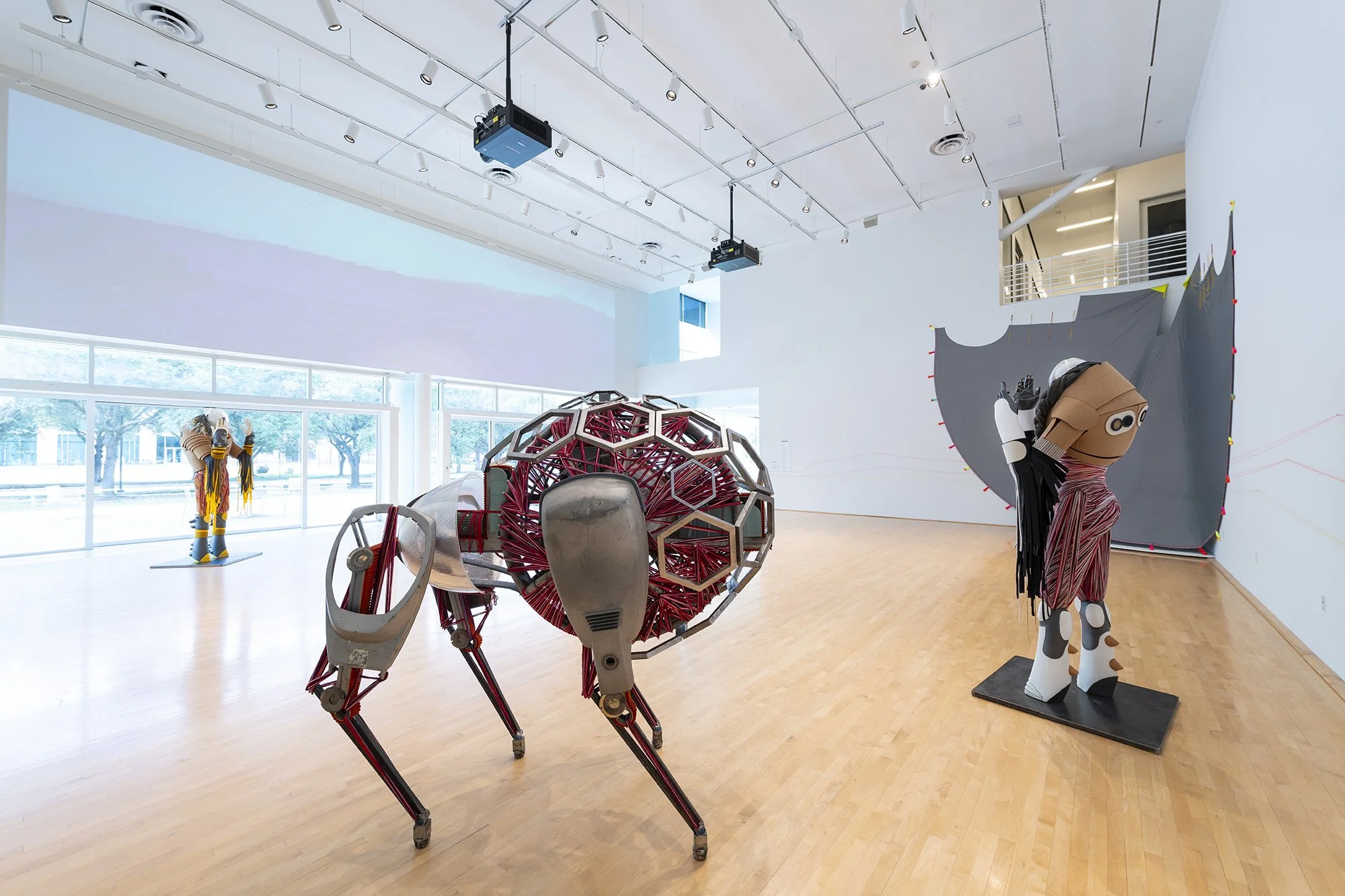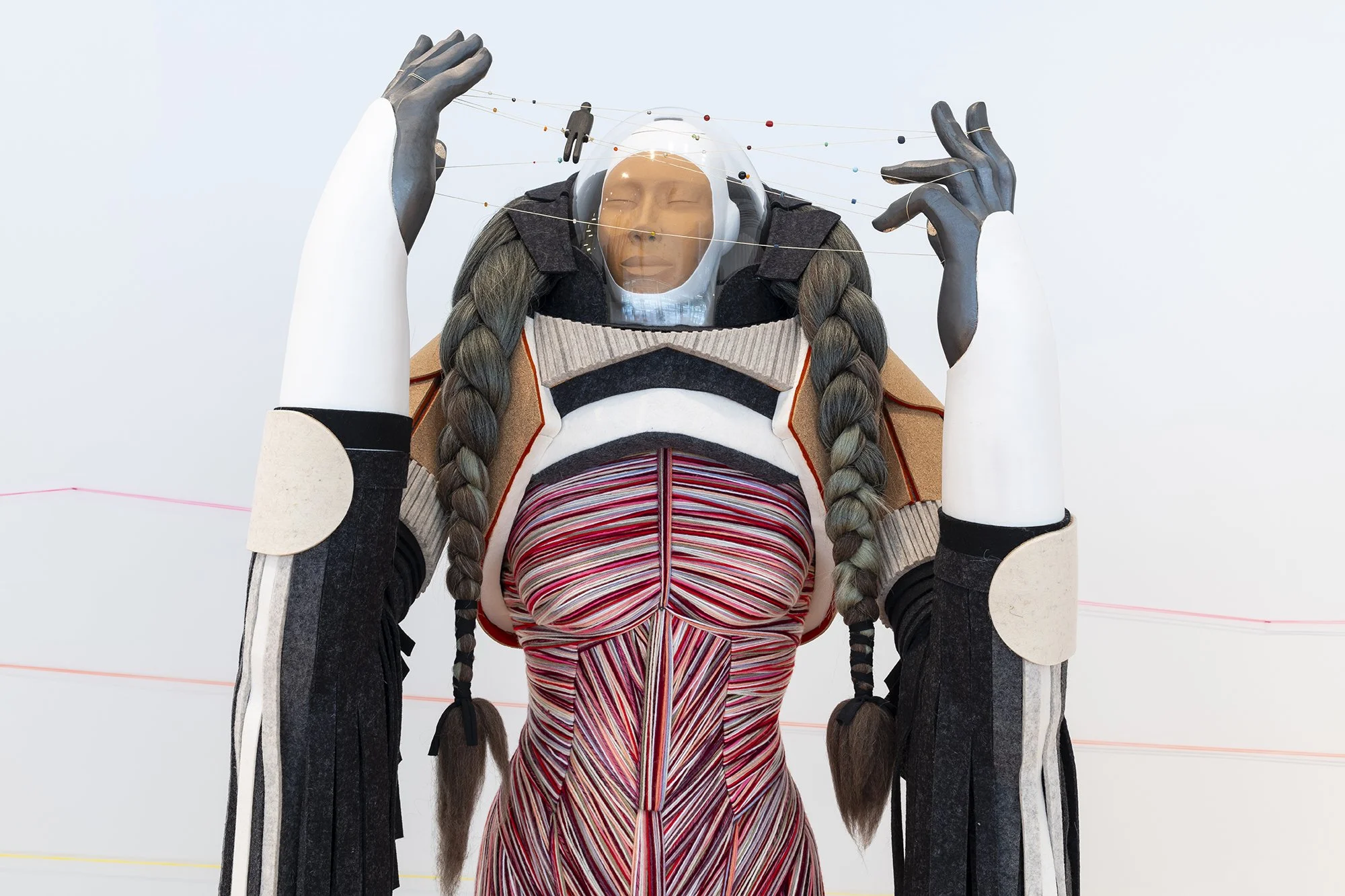Dreaming While Awake: Cannupa Hanska Luger’s Sovereign
By May Howard | March 31, 2025
The Art Critic Fellowship is an art writing intensive program launched in 2025. Over eight weeks, fellows engaged in four lectures led by award-winning editors and writers to discuss the joys and concerns of writing and editing art criticism today, and met one-on-one with their assigned mentors to develop a piece of criticism for publication on AICA-USA’s Magazine.
May Howard is part of the 2025 cohort and was paired with Tausif Noor as her mentor.
We have always traveled in dream
And dream is matter not yet created
You build with dream the world we inhabit
-Cannupa Hanska Luger, Through the Worldline, 2024
In eschatological traditions, the apocalypse is revealed through fugal dreams or visions to bring prophetic revelation. Today, it is synonymous with the catastrophic end: total ecological and spiritual death. The apocalypse is no longer delegated to a future imaginary; it resides in the omnipresent now. Rather than a singular, fiery dystopian end-event, apocalypse arrives as a slow unfolding of accumulative actions on a global scale.
Cannupa Hanska Luger, an artist of Mandan, Hidatsa, Arikara, and Lakota descent, blends installation, sculpture, performance, and video with science fiction inspired worldbuilding in his series Future Ancestral Technologies (2018-present) to craft a speculative post-apocalyptic future in which tools of Indigenous resilience structure the reciprocal survival of both humanity and the planet. A recently unveiled multimedia installation by Luger titled Sovereign (2024) at Rice University’s Moody Center for the Arts is the latest addition to the series and considers the unique ecological awareness that emerges from a politics of coexistence rooted in Indigenous relations of kin-making. Originally commissioned for the Hammer Museum’s group exhibition Breath(e): Toward Climate and Social Justice as part of PST ART by curators Glenn Kaino and Mika Yoshitake, Sovereign was remounted as a site-responsive installation when the exhibition traveled to Houston. Sovereign stages an encounter between three life-size cosmic travelers fashioned in “sovereignty suits” accompanied by their reflective teepee vessel, a droid, and us, the viewers. Luger critically engages science fiction and narratives of space exploration to reveal how Indigenous knowledge(s) can reframe approaches to apocalyptic thinking, especially pertaining to the climate crisis.
Like all good science fiction, Sovereign begins with immersive storytelling to invite the viewer to imagine what emerges after the end of the world. Sovereign is just one act in the larger narrative scope of Luger’s Future Ancestral Technologies series, which conceives a future where half the population abandon the planet after extracting tremendous natural resources to escape. Those who remain on Earth, shepherd its healing. These future ancestors carry genealogies of knowledge to restore the weakened threads that exist between people and land. They carry technologies of dreams, stories, regalia, adornments, myth and dance.
Left: Cannupa Hanska Luger, gagúwi (Sovereign Series), 2024, ceramic, steel, glass, fiber, paper, detritus, dimensions variable.
Right: awáasha (Sovereign Series), 2024, ceramic, steel, felt, paper, cork, wood, synthetic hair, glass, dimensions variable. Breath(e): Toward Climate and Social Justice, Moody Center for the Arts at Rice University. Photo by Anthony Rathbun.
Three anthropomorphic travelers, with Hidatsa titles of awáasha (bean), gagúwi (squash), góoxaadi (corn), stand dressed in suits designed for cosmic voyage. Constructed with repurposed textile and fibers, the tactile suits, each wonderfully varied in color and detail, suggest a self-protective purpose for their nomadic wearer. Natural cork panels surround the neck and shoulders of each traveler, resembling a soft exoskeleton. Multi-colored thread rhythmically wraps around their upper bodies like ligaments, articulating their torsos and upper legs. This pliable barrier of intricately positioned thread comprises the interstitial fabric between inner and outer space. To protect their breath, the travelers, with faces carved of clay, wear clear, translucent helmets. Long braided hair falls from their helmets echoing the long, thick strips of felt dangling from their elbows. With closed eyes, the travelers hold their gloved hands—outstretched and deliberate—in front of their faces. Delicate strings are interwoven between their fingers, some containing a suspended figurine caught between the web. Unlike the sleek, streamlined cyberscape of popular culture sci-fi films like Tron (1982) or Blade Runner (1982), these space travelers adorn themselves in regalia of reused clay, fiber, cork, and string. Using these craft materials to upend visual expectations of technological advancement, Luger seeks to expand definitions of technology beyond a progressivist narrative rooted in computing mechanisms or algorithms. The craftsmanship evident in Luger’s process of making, including material collection and recovery, reveal traces of the handmade as archival marks of human experience and intervention; like time machines, the “sovereign suits” channel traditions of ancestral craft and embodied knowledge.
Cannupa Hanska Luger, Sovereign, 2024, ceramic, steel, glass, fiber, paper, detritus, 3-channel video projection, sound installation, dimensions variable. Breath(e): Toward Climate and Social Justice, Moody Center for the Arts at Rice University. Photo by Anthony Rathbun.
Stretched across a corner of the gallery opposite the travelers is an iridescent, hyperreflective teepee titled We Are Live II (2023). A four-legged droid, absent of facial features, named Red Rover stands alongside one of the travelers as an intergalactic cyber-companion. With a body composed of linked steel hexagonal shapes, discarded objects, and loosely bound multicolored thread, Red Rover’s presence highlights the importance of communing with interspecies kin. The abundance of threadwork present throughout the installation contours the spaces between the travelers, Red Rover, and the teepee. Luger uses this humble, everyday thread to mark the connection and fluidity between things. Singular strands of colored thread line the surrounding gallery walls, hinting at concepts of lineage or cartography. An accompanying poem authored by Luger titled Through the Worldline is placed near the start of the exhibition, further narrating themes of interrelation and dependency. In visualizing these ties, Luger alludes to the material kinship connecting humans with land and all its cohabitants. The threads also denote a temporal significance, representing the deeper binds of space, time, culture, and memory that form a complex web known as futurity.
Sovereign shares affinities with literary modes of Indigenous speculative and science fiction that experiment, reverse, or subvert genre tropes and expectations. Anishinaabe scholar and cultural critic Grace Dillon puts forth the phrase “Indigenous futurisms” to describe distinctive visions that exist outside of normative structures of time and space in which sovereignty is realized for all Indigenous peoples. In the Indigenous futurism he creates with Sovereign, Luger is acutely aware of the grammar of settler colonialism evident in science fiction literature and film, particularly in the framing of space exploration as the new frontier. His work references how tropes of first contact, mythical discovery of new worlds, and themes of conquest, extraction, or invasion disguised as “adventure,” emulate the colonial enterprise of expansion. Luger’s methods of immersion—large scale, multimedia, and site-responsive— invite viewers into contact with the travelers, reversing the discovery trope of “alien” lifeforms so that these travelers appear to have come to us.
Within the framework of science fiction, Luger plays with concepts of non-linear temporality, multiplicity, and parallel worlds to reinscribe the presence of Indigenous life and cosmologies. Sovereign is the material manifestation of Luger’s post-colonial, post-capitalist future of Indigenous survival.
Cannupa Hanska Luger, góoxaadi (Sovereign Series), 2024, ceramic, steel, felt, paper, cork,wood, synthetic hair, glass, dimensions variable. Breath(e): Toward Climate and Social Justice, Moody Center for the Arts at Rice University. Photo by Anthony Rathbun.
By way of metaphor, it is clear how Luger uses science fiction to obliquely represent aspects of North American Indigenous experience. The travelers exist in a world where they must reclaim the material detritus cast aside by the Earth’s previous inhabitants, asserting that value can be found in the preexisting world all around us. The Lakota word watȟéča translates to leftovers, and in an ecological context, embodying a scavenger can help us reconsider material as more than a commodity to be possessed, extracted, and ultimately depleted. The scavenger is evoked elsewhere throughout Luger’s practice, often appearing as a coyote or buzzard. In a recent essay published in Future Imaginaries: Indigenous Art, Fashion, Technology (2024), Luger writes of how scavengers thrive despite land loss and environmental corrosion because of their ability to stealthily reclaim or salvage what all others reject.
Though the totalizing effects of apocalypse are universal, Sovereign signals how the idea or experience of apocalypse can be culturally specific. As Grace Dillon so crucially indicates in the introduction to Walking the Clouds: An Anthology of Indigenous Science Fiction (2012), “It is almost commonplace to think that the Native Apocalypse, if contemplated seriously, has already taken place.” In Indigenous science fiction, Native apocalypse refers to a re-telling of catastrophic events in which Indigenous peoples retain their sovereignties, overcome struggles against colonial adversaries and ideologies, and are centered in the imagining of a better future. It is from this Indigenous lens of apocalypse that Luger arrives at a politics of co-existence that recognizes the belonging and potentiality of more-than-human entities as coexisting beings. A stanza from Through the Worldline animates the collective voice of the travelers that speaks to themes of mutual acknowledgement and care:
We desire your counsel
Focus your intentions on the burdens we carry
Much has been lost and much has been gained
Across the distances between us
You exist here as much as we exist there
While apocalyptic thinking dominates climate discourse today, Sovereign importantly argues that dreaming of a post-apocalyptic future is a political exercise and that it is worthwhile to reimagine our relationship with non-human beings. The installation is rich in symbolism, strongly narrating how adaptability, dreaming, and interdependency are tools of survival. Dreaming against apocalypse troubles disaster narratives by seeking alternative futures of transformation or renewal. Luger’s work reminds us that to grapple with the horror of one apocalypse, it is critical to conceptualize the world that waits beyond it and into the realm of survival.
Luger’s multi-channel video of a treeline on Rice University’s campus flashes subtly, high against the gallery wall, glitching between static images in a loop of past and present. Live oak trees comprise roughly half of the four thousand trees on the university campus. Each tree contains its own interior universe of death and regeneration. One can only imagine the wisdom and memory accumulated within their concentric rings, dating some of these trees to five hundred years. Many may far outlive us. As Luger’s powerful work reminds us, it is in our best interest to learn how to survive an apocalypse from the knowledge they contain.
May Howard is a writer, artist, and curator whose work explores the artistic interdependencies between materiality, process, technology, and the body. Her multidisciplinary practice centers the social and political dimensions of spaces and objects. Howard received an M.A. in Art History, Theory and Criticism from the School of the Art Institute of Chicago in 2022. She currently serves as the Curatorial Assistant of Decorative Arts, Craft, and Design at the Museum of Fine Arts, Houston. Her writing has appeared in Glasstire, Surface Design Journal, and Burnaway.




